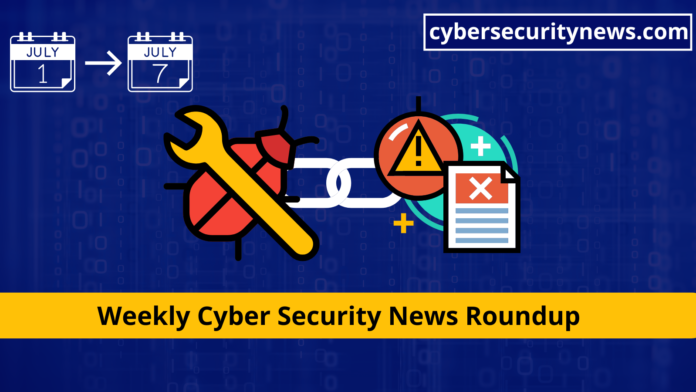Weekly Cyber Security Update
Weekly Cyber Security News Round-Up
Overview
The latest weekly cyber security newsletter provides a comprehensive summary of recent threats, vulnerabilities, and innovations in the digital security space. This update is critical for organizations and individuals to adapt their security protocols and maintain robust system protection against evolving cyber threats.
Key Threats
- Hackers Weaponizing ScreenConnect Remote Access
- Hackers are using a fake version of ScreenConnect to install the AsyncRAT trojan, applying complex tactics to avoid detection. Recommended defenses include Endpoint Detection and Response (EDR), Phishing and Security Awareness Training (PSAT), and strong password management.
- Team ARXU Hackers
- This international group targets schools and banks to steal personal and financial data, selling it on the dark web. Their activities include DDoS attacks, data breaches, and website defacement. A multi-tiered defense strategy is advised.
- Open-Source Neptune Stealer
- Distributed via GitHub, this malware steals sensitive data and can be modified to evade detection. Preventive measures include verifying code origins, using reputable security software, and enabling multi-factor authentication.
- Volcano Demon Ransomware Group
- Targets Windows and Linux systems, hijacking administrative passwords and encrypting files. They use stolen admin credentials for double extortion. Strong defenses against these tactics include regular software updates and security patches.
- Anatsa Banking Malware
- Distributed through a malicious QR code reader app on Google Play, Anatsa steals financial data via keyloggers and remote access. Users are advised to download apps only from trusted sources.
- New InnoSetup Malware
- Targets users downloading pirated software, capable of running arbitrary code. Emphasizes the importance of purchasing legitimate software and avoiding pirated versions.
- FakeBat Malware
- Uses popular apps like AnyDesk and Zoom to spread malware. Distributed through drive-by downloads, malvertising, and social engineering, utilizing advanced obfuscation techniques.
- HappyDoor Executed Via regsvr32 File
- Used by the Kimsuky APT group to evade detection and target South Korean entities. Misuses the Windows utility regsvr32.exe to execute malicious payloads.
- Hackers Using Polyglot Files
- Polyglot files can evade security measures by appearing as multiple file types. The PolyConv tool helps create such files, complicating detection by antivirus solutions.
- CapraRAT Mimics Popular Android Apps
- Steals user data and performs malicious activities by mimicking real Android apps. Users should download apps from official stores only.
Notable Vulnerabilities
- Steals user data and performs malicious activities by mimicking real Android apps. Users should download apps from official stores only.
- PoC Exploit for HTTP File Server RCE Flaw
- A critical vulnerability (CVE-2024-39943) in HTTP File Server software allows remote code execution. Users should update to version 0.52.10.
- ProxyLogon & ProxyShell Exploits
- These vulnerabilities in Microsoft Exchange servers are still actively exploited, emphasizing the need for timely patches and updates.
- Splunk Enterprise Vulnerabilities
- Multiple vulnerabilities allowing remote code execution and denial-of-service attacks have been patched. Users should update to the latest versions.
- CocoaPods Vulnerability
- Critical flaws in the CocoaPods dependency manager expose iOS and macOS apps to supply chain attacks. Recent patches address these issues.
- Intel CPU Vulnerability: Indirector Attack
- A high-precision Branch Target Injection (BTI) attack affects recent Intel CPUs. Researchers recommend using the Indirect Branch Predictor Barrier (IBPB).
- Gogs Vulnerabilities
- Two critical vulnerabilities in the Gogs Git hosting platform allow path traversal and remote code execution. Users should update to the latest version.
- Regresshion RCE Vulnerability
- A remote code execution vulnerability in the Regresshion testing framework requires immediate updates to the latest version.
Cyber Attacks
- A remote code execution vulnerability in the Regresshion testing framework requires immediate updates to the latest version.
- TeamViewer Investigation
- TeamViewer disclosed an investigation into unauthorized access, assuring no evidence of data breach. Users are advised to remain vigilant.
- SnailLoad Side-Channel Attack
- Exploits network latency to infer user actions with high accuracy. This method works without active involvement from any internet server.
- Kematian Stealer
- A sophisticated PowerShell malware that exfiltrates sensitive data via Discord webhooks.
- Malicious PDF Files
- Phishing campaign using PDF files disguised as Microsoft 2FA warnings to steal login credentials.
- HTTP File Server RCE Flaw
- Actively exploited vulnerability (CVE-2024-23692) in HFS software used for cryptocurrency mining and information stealing.
Other News
- Actively exploited vulnerability (CVE-2024-23692) in HFS software used for cryptocurrency mining and information stealing.
- Operation Morpheus
- An international operation dismantled 593 malicious Cobalt Strike servers, albeit temporarily disrupting cybercriminal activities.
- Proton’s Encrypted Document Editor
- Proton launched ‘Docs,’ a privacy-focused, end-to-end encrypted document editor, competing with Google Docs and Microsoft 365.
- Record-Breaking DDoS Attack
- Mirai-like botnets set new records in DDoS attacks, with peaks observed up to 2.5 Tbps. This highlights the evolving threat landscape.
- Cloudflare Service Outage
- A bug led to a significant outage affecting many websites. Cloudflare has since resolved the issue and emphasized no loss of customer data.
This summary encapsulates the latest developments in cybersecurity, stressing the need for vigilance, timely updates, and robust security measures.
- A bug led to a significant outage affecting many websites. Cloudflare has since resolved the issue and emphasized no loss of customer data.

